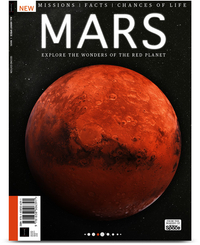A new year begins on Mars as three space probes close in on the Red Planet

Happy new year! On Mars at least.
Yesterday (Feb. 7) marked the beginning of a new year on the Red Planet. While a year on Earth lasts 365 days, every Mars year lasts 668 sols (Mars days) — or 687 Earth days, as each sol lasts a little longer than an Earth day at 24 hours and 39 minutes. Because the Red Planet takes almost twice as long to orbit the sun as Earth, on Mars, you would celebrate your birthday every 23 Earth months.
This is now "Mars Year 36" on Mars as tracked by humans on Earth. "Mars Year 1" began after a significant dust storm was detected in 1956, named "the great dust storm of 1956." To calculate how old you would be on Mars, you can divide your age by 1.88 (but take note: traveling to Mars wouldn't actually make you younger).
The Martian new year begins as three different missions are closing in on the Red Planet. The United Arab Emirates' Hope orbiter is due to arrive in orbit around Mars on Tuesday (Feb. 9). A day later, China's Tianwen-1 mission is also expected to enter orbit. Tianwen-1 is carrying three different probes: an orbiter, lander and small rover. Then on Feb. 18, NASA's Mars rover Perseverance will make a daring landing via a parachute and sky crane in a region known as Jezero Crater. So, it's going to be a busy year on the Red Planet.
Related: How long does it take to get to Mars
Book of Mars: $22.99 at Magazines Direct
Within 148 pages, explore the mysteries of Mars. With the latest generation of rovers, landers and orbiters heading to the Red Planet, we're discovering even more of this world's secrets than ever before. Find out about its landscape and formation, discover the truth about water on Mars and the search for life, and explore the possibility that the fourth rock from the sun may one day be our next home.
Mars has four seasons just like we do on Earth, with cooler winters and warmer summers. The Martian year always begins with the northern hemisphere's spring equinox, which begins autumn in the southern hemisphere.
However, unlike Earth's, Mars' seasons are not all the same length. This inequality is because the Red Planet's orbit around the sun is a more extreme elliptical shape than Earth's. The season we are now entering, spring in Mars' northern hemisphere, is the longest season on the planet, lasting 194 sols.
Breaking space news, the latest updates on rocket launches, skywatching events and more!
Also unlike Earth, Mars experiences much more extreme temperatures. The planet's yearly average temperature is minus 76 degrees Fahrenheit (minus 60 degrees Celsius).
Additionally, during the Martian spring and summer in the planet's southern hemisphere, the Arsia Mons Elongated Cloud, a strange weather phenomenon that is essentially a giant ice crystal cloud stretching 1,100 miles (1,800 kilometers) can form and last for over 80 sols.
Because of the planet's more elliptical orbit, Martian seasons can additionally bring a variety of strange effects. For example, during spring and summer in the planet's southern hemisphere, Mars is closer to the sun and moving faster. The closer proximity to the sun warms the planet's atmosphere, and the increased warmth and the planet's increased speeds whipping around so close to the sun stir up particles in the Martian soil, which can lead to intense dust storms that can stretch around the entire globe.
In fact, in 2019, NASA's Opportunity rover "died" after a global dust storm covered the craft's solar arrays, preventing its batteries from charging and causing it to lose contact with mission teams on Earth.
Email Chelsea Gohd at cgohd@space.com or follow her on Twitter @chelsea_gohd. Follow us on Twitter @Spacedotcom and on Facebook.
Join our Space Forums to keep talking space on the latest missions, night sky and more! And if you have a news tip, correction or comment, let us know at: community@space.com.

Chelsea “Foxanne” Gohd joined Space.com in 2018 and is now a Senior Writer, writing about everything from climate change to planetary science and human spaceflight in both articles and on-camera in videos. With a degree in Public Health and biological sciences, Chelsea has written and worked for institutions including the American Museum of Natural History, Scientific American, Discover Magazine Blog, Astronomy Magazine and Live Science. When not writing, editing or filming something space-y, Chelsea "Foxanne" Gohd is writing music and performing as Foxanne, even launching a song to space in 2021 with Inspiration4. You can follow her on Twitter @chelsea_gohd and @foxannemusic.

